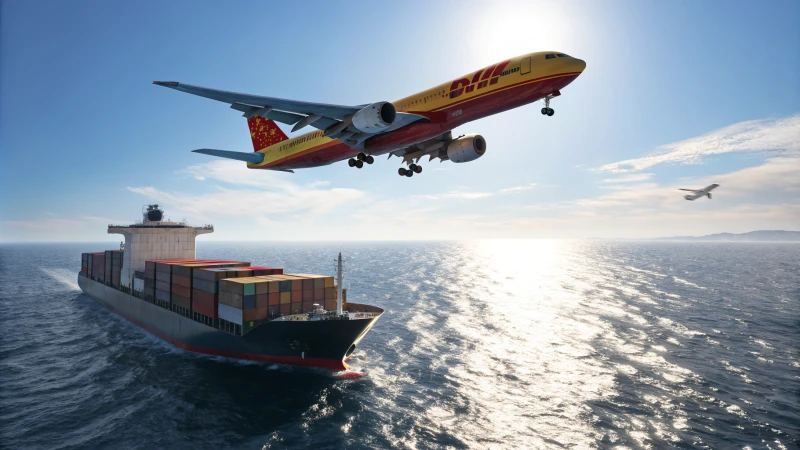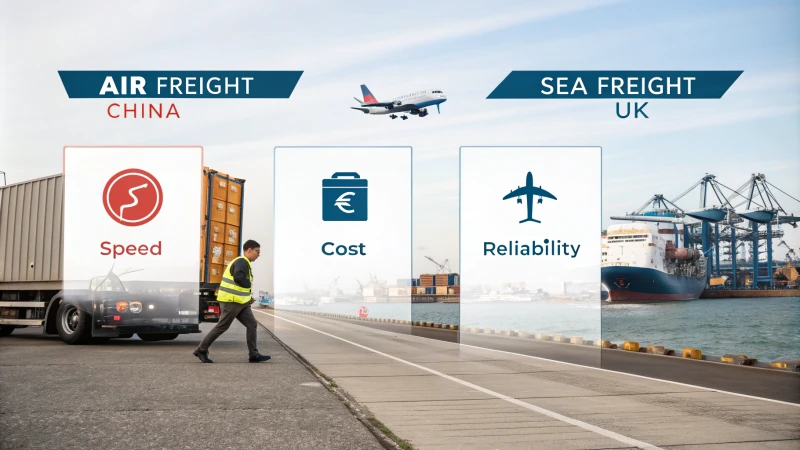I remember when I began navigating international shipping. It felt like solving a puzzle with missing pieces. Picking the best shipping method from China to the UK often seems just as confusing. I'm here to help you understand it better!
The best way to ship items from China to the UK depends on your main concerns. Speed, cost or reliability may guide your decision. Air freight suits urgent shipments. Maybe, it is the perfect choice. Sea freight fits larger and less urgent loads. Balancing these factors is very important. Consider and select what suits your needs best.
Let's explore the choices together. Shipping brings back memories of my early days in the import/export business. I felt like a juggler choosing between air and sea freight. Costs and delivery times demanded my attention like a circus act. Each method has its own character. Air freight is like a fast friend, always on time. Sea freight moves at a relaxed pace, ideal for large shipments that don't mind delays. I found what suited my business. Balancing speed, costs and trust became my focus.
This article will discuss each shipping option in detail, including their pros and cons, costs and how they match your specific business needs. I hope my insights help clarify your shipping decisions.
Air freight is the fastest shipping method from China to UK.True
Air freight is known for its speed, making it ideal for urgent shipments.
Sea freight is more expensive than air freight for small loads.False
Sea freight generally offers lower costs, especially for larger shipments.
What are the benefits of air freight versus sea freight?
Understanding shipping options might feel really confusing, especially when choosing between air freight and sea freight. I recall having this exact challenge. It is a journey worth exploring together!
Air freight provides important benefits compared to sea freight. It is faster, more reliable and safer. Air transport suits urgent and valuable packages. However, it costs more. People need to weigh this expense against their shipping requirements.

Speed and Efficiency
One of the most significant advantages of air freight is its speed. When time is of the essence, air freight delivers goods quickly, often within 1-3 days globally. In contrast, sea freight can take weeks, depending on the distance and port schedules. This makes air freight ideal for urgent shipments, especially in industries like electronics or fashion where trends change rapidly.
For example, a few years ago, I faced a tough situation when my electronics store planned to launch a new line of gadgets that excited everyone. But we had a problem: our shipment from overseas was delayed by sea freight. I felt panic knowing my customers would be disappointed if we couldn’t deliver on time. Then I learned how useful air freight really is. Picture my relief when I used air freight and received the products just in time for our launch! It changed everything.
| Here’s a simple comparison table: | Mode of Transport | Speed |
|---|---|---|
| Air Freight | Fast (1-3 days) | Higher cost per kg |
| Sea Freight | Slow (weeks) | Lower cost per kg |
This table highlights the trade-offs between choosing air or sea freight based on urgency and cost.
Cost Considerations
While air freight is faster, it comes at a higher cost. Businesses often need to weigh the importance of speed against budget constraints. For larger shipments where cost savings are critical, sea freight can be more economical despite its longer transit times.
I remember choosing during that launch: using sea freight would have saved some money, but still, the potential loss from fewer sales would have been much bigger. Finding the right spot between urgency and expense is vital.
Reliability and Safety
Air freight generally offers higher reliability in terms of schedules and fewer delays compared to sea freight. Additionally, air transport is less susceptible to damage due to shorter transit times and better handling procedures. This reliability can be crucial for high-value items, ensuring that products reach their destination safely and on time.
From my experience, I have shipped delicate items like electronics using air freight; I knew they would arrive safely and on time. For fragile goods requiring careful handling, express air freight services1 became my go-to solution.
Suitable Shipment Sizes
Air freight works best for smaller, high-value items. If Jack imports a new line of consumer electronics that are lightweight but valuable—like cutting-edge headphones—air freight could be the perfect fit! Sea freight might suit larger volumes where weight and size don’t matter as much.
Sometimes I mix both methods for speed and cost benefits; flexibility can make all the difference!
Conclusion Factors
When choosing between air and sea freight, think about what matters most to your business. For me, it often depends on the nature of my goods and delivery deadlines. Understanding these factors improved my logistics decisions—they aligned better with my overall business goals. It's about choosing wisely for your unique needs.
Air freight delivers goods in 1-3 days globally.True
Air freight is significantly faster than sea freight, making it suitable for urgent shipments that require quick delivery.
Sea freight is more cost-effective for large shipments.True
For bulk shipments, sea freight is generally cheaper despite longer transit times, making it a better option for budget-conscious businesses.
How does rail freight compare to other shipping methods?
Do you ever wonder about the best way to send your goods? Comparing rail freight with other choices really helps you decide what's best for your transport needs. Rail freight has unique features. Understanding these features is very important. Simple choices lead to smart decisions.
Rail freight provides an affordable option for transporting large shipments across long distances. This method balances speed and environmental impact. It also offers more reliability compared to air and sea shipping. Rail freight really blends these benefits.
When I began my wholesale business, I felt confused by the many shipping methods. The choices seemed endless, with each having its pros and cons. I remember struggling about shipping my latest consumer electronics order from China. Should I choose the speed of air freight or the cheaper rail option? Many business owners face this dilemma. It is very important to consider all factors before deciding.
Cost Efficiency of Rail Freight
Rail freight offers big cost savings, especially for large shipments. The following table illustrates this:
| Shipping Method | Cost per Ton-Mile | Typical Use Case |
|---|---|---|
| Air Freight | $2.00 - $5.00 | Urgent, small shipments |
| Truck Freight | $1.50 - $3.00 | Regional deliveries |
| Rail Freight | $0.10 - $0.50 | Bulk goods, long distances |
| Sea Freight | $0.05 - $0.30 | Large volume, intercontinental |
Switching to rail for bigger orders saved me a lot on logistics expenses. The savings were game-changing for my business as I invested more in marketing and growth.
Speed Comparison
Rail freight is good for saving money, but I also thought about speed. Air freight is known for its speed - great for urgent shipments! Here’s a breakdown:
- Air Freight: 1-3 days
- Truck Freight: 2-7 days depending on distance
- Rail Freight: 3-10 days
- Sea Freight: 20-40 days
If speed matters most, air freight or express options like DHL2 are worth considering. However, if you accept a few extra days, rail freight offers a fine balance.
Environmental Impact
Sustainability is important too. Rail freight is a greener choice compared to truck and air transport. According to various studies, rail transportation emits approximately 75% less CO2 per ton-mile than trucking:
| Shipping Method | CO2 Emissions (grams per ton-mile) |
|---|---|
| Air Freight | 500 |
| Truck Freight | 200 |
| Rail Freight | 45 |
| Sea Freight | 10 |
This fact is really impressive and if your brand values sustainability - like mine does - this eco-friendly option may weigh heavily in your decision.
Reliability and Safety
Reliability in shipping holds great importance. Early on, I faced delays with trucking due to unexpected traffic; definitely not ideal for building trust with clients! Here’s a reliability ranking:
- Rail Freight: Consistent schedules; less affected by weather and traffic.
- Sea Freight: Generally reliable but can face port delays.
- Truck Freight: Very flexible yet vulnerable to traffic issues.
- Air Freight: Fast yet sensitive to weather delays.
Stable delivery times with minimal disruptions make rail freight a great choice.
Conclusion: Making the Right Choice
Choosing between rail freight and other methods involves several factors like cost efficiency, speed requirements, environmental impact and reliability. Understanding these elements helps me make informed decisions that align with my business goals allowing me to thrive in a competitive market.
Rail freight is the most cost-effective shipping method.True
Rail freight is significantly cheaper than air and truck freight, especially for bulk goods over long distances, making it a cost-efficient option.
Air freight is faster than rail freight for deliveries.True
Air freight typically delivers shipments in 1-3 days, making it faster than rail freight, which takes 3-10 days for delivery.
What factors should you consider when choosing a shipping method?
Understanding the world of shipping feels very overwhelming. However, choosing well probably transforms everything for your business. Let us explore what I believe is crucial when selecting a shipping method. This choice should really match my needs.
When choosing a shipping method, think about speed and cost. Check the type of goods you need to ship. Look at weight and size, too. Distance and destination matter as well. Reliability is very important. Security is also crucial. These factors help refine your logistics process.

When selecting a shipping method, several factors must be considered to ensure optimal logistics. Let's explore some of these key considerations:
Speed vs. Cost
One of the primary factors is the balance between speed and cost. If you're in a hurry and need to deliver products quickly, options like air freight are ideal, but they often come at a premium price. Conversely, if you can afford to wait, sea freight is generally cheaper for larger shipments.
For instance, if I need to ship electronics urgently for a big sale, I might opt for express services like DHL3 or FedEx4. However, when I have more time for large shipments, sea freight saves me a lot of money.
Nature of Goods
The type of products being shipped significantly influences the choice of shipping method. Fragile or perishable items may require special handling, and air freight could be the best option due to faster transit times. Here's a simple table summarizing this:
| Type of Goods | Recommended Shipping Method | Reasons |
|---|---|---|
| Electronics | Air Freight | Speed and safety |
| Clothing | Sea Freight | Cost-effective for bulk shipments |
| Perishable Foods | Air Freight | Reduced spoilage risk |
| Heavy Machinery | Sea Freight | Cost efficiency for heavy loads |
I once panicked while shipping fragile electronics; fast shipping was a must because fast transit times are crucial for delicate goods.
Weight and Size
The weight and dimensions of your shipment can also dictate the best shipping method. Heavier and larger items are typically more economical to ship by sea, while lighter items can be sent via air without incurring high costs. Additionally, different carriers have various size limits and pricing structures.
For example, lightweight parcels can often be shipped through EMS5 or China Post, which offer budget-friendly options for smaller packages.
Distance and Destination
Shipping distances play a crucial role in determining the best method. For shorter distances within the UK, ground shipping may suffice; however, long distances often necessitate faster options like air freight. My choice will depend on whether I am shipping domestically within the UK or internationally from China.
Reliability and Security
Finally, the reliability of the shipping service is paramount. Researching carrier reputations and customer reviews can provide insight into their reliability. For high-value items, choosing a method with tracking and insurance options is wise. Services like UPS offer comprehensive tracking features that enhance security during transit.
In summary, when choosing a shipping method, it's essential to assess various factors including speed versus cost, nature of goods, weight and size, distance and destination, as well as reliability and security to make informed decisions tailored to specific logistics needs.
Air freight is faster but more expensive than sea freight.True
Air freight offers quicker delivery times compared to sea freight, which is generally cheaper but slower.
Heavy machinery should always be shipped by air for safety.False
Heavy machinery is more cost-effective to ship by sea, not air, due to weight and size considerations.
How can you calculate the cost of shipping from China to the UK?
Transporting products from China to the UK may seem difficult. However, it doesn't need to be. Understanding the main methods and factors involved is crucial. This knowledge gives you the power to choose wisely. Very wise choices match your specific needs.
To find the cost of sending goods from China to the UK, look at factors like weight and size. Include delivery speed in your considerations. Pick between air, sea or train for sending your items. Use websites to get exact price guesses.

Understanding Shipping Methods
When I began shipping items from China, I felt lost with all the available options. It seemed like navigating a maze. Each shipping method has its own peculiarities. These differences really impact costs and delivery times.
- Air Freight: This method works best for smaller shipments when I need them quickly. It once saved me during a tech expo for a last-minute order.
- Sea Freight: For larger shipments, use sea freight to save money. It isn’t the fastest choice, though.
- Rail Freight: This option offers moderate costs and delivery times. It is good for reliability when some delay is okay.
For detailed information, see shipping methods comparison6.
Factors Influencing Shipping Costs
As I explored shipping logistics, I found several factors that greatly change costs:
- Weight and Volume: Heavier or bigger items really increase expenses. I once shipped very bulky electronics that were much heavier than planned. It taught me a big lesson. Measure carefully!
- Shipping Distance: Long journeys usually cost more.
- Delivery Speed: Urgent deliveries need express services, which are more expensive.
- Customs and Duties: Don’t ignore customs fees. They often add unexpected costs if you're not ready.
Here's a table summarizing how these factors might affect costs:
| Factor | Impact on Cost |
|---|---|
| Weight | Higher cost for heavier items |
| Volume | Larger items increase cost |
| Delivery Speed | Express = more cost |
| Customs & Duties | Variable additional cost |
For more information, check shipping costs breakdown7.
Using Shipping Calculators
Online shipping calculators are really helpful! They have saved me lots of time from manual calculations.
- DHL: Their calculator is simple and easy - just enter your details and get results.
- FedEx: Provides real-time quotes which help a lot with budgeting.
For more details, visit shipping calculators guide8.
Best Practices for Cost Efficiency
Over time, I learned some practices for keeping shipping rates low:
- Consolidate Shipments: Combining multiple items into one shipment saves a lot of money.
- Negotiate Rates: Frequent shippers should negotiate better rates with freight forwarders. It is really worth it.
- Choose the Right Service: Match your service choice with urgency. Sometimes waiting saves significant amounts.
For negotiation tips, see negotiation strategies9.
Air freight is the fastest shipping method from China to the UK.True
Air freight offers speed for smaller shipments, making it ideal for urgent deliveries.
Sea freight is always the cheapest option for shipping from China.False
While sea freight is cost-effective for large shipments, it may not be the cheapest for all scenarios.
Conclusion
Explore the best shipping methods from China to the UK, weighing factors like speed, cost, and reliability to find the right fit for your business needs.
-
Discover the latest trends in logistics that highlight the reliability of air freight services over sea options. ↩
-
Discovering comprehensive comparisons can enhance your understanding of each shipping method's strengths and weaknesses. ↩
-
Understanding these factors will help you optimize your shipping strategy effectively. ↩
-
Learn more about the different shipping methods available for various goods. ↩
-
Discover tips on how to choose a reliable shipping provider. ↩
-
This link provides insights into shipping costs and methods that can help you choose the right option for your needs. ↩
-
This resource breaks down the factors affecting shipping costs in detail, aiding in budgeting for your shipments. ↩
-
Utilizing these calculators will streamline your process of estimating shipping costs based on your specific needs. ↩
-
Learn how to negotiate better rates with carriers to save money on your shipping expenses. ↩




